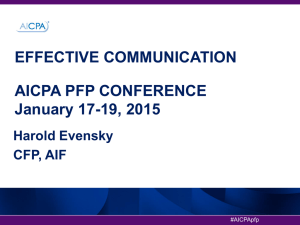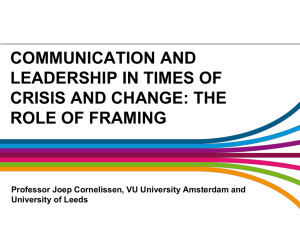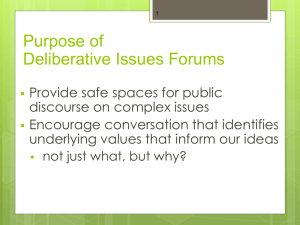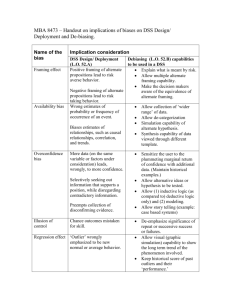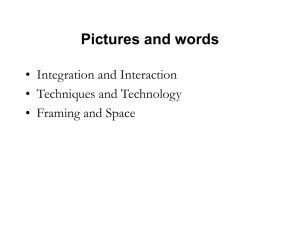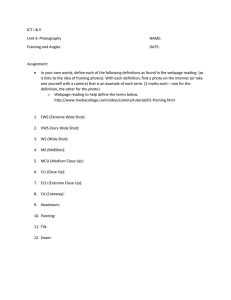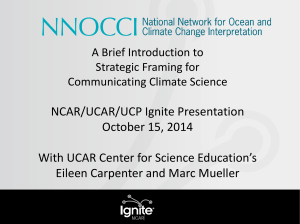Hartman, Todd K. and Christopher R. Weber. (2009) "Who said... cues in issue frames." Political Behavior. Vol 31, no....
advertisement
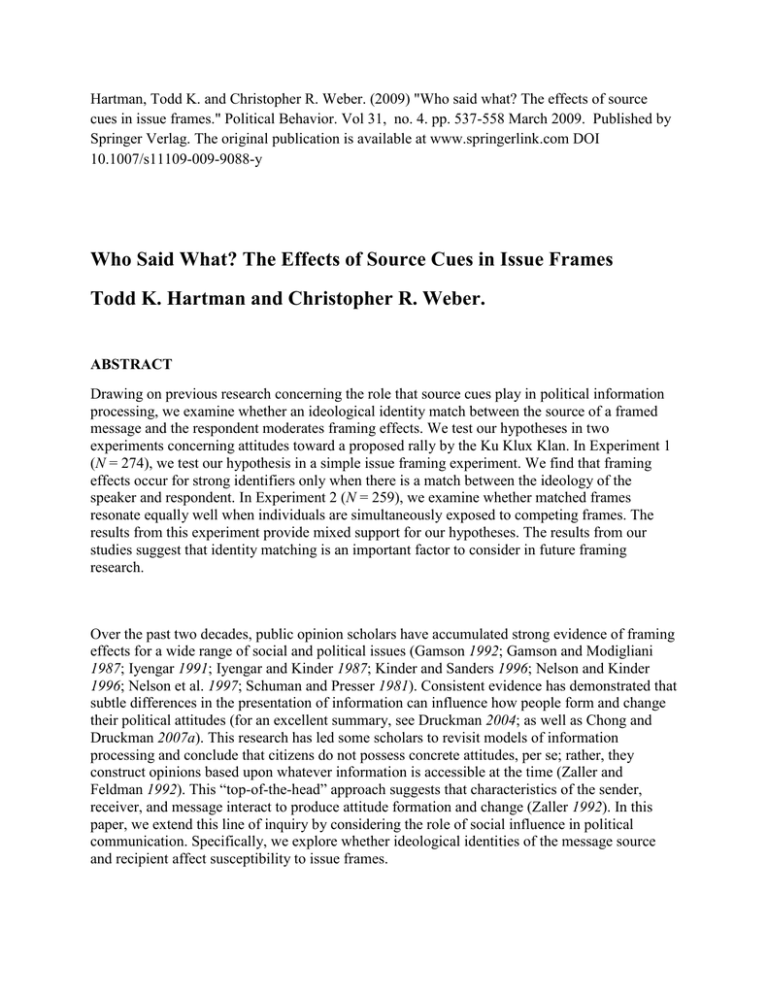
Hartman, Todd K. and Christopher R. Weber. (2009) "Who said what? The effects of source cues in issue frames." Political Behavior. Vol 31, no. 4. pp. 537-558 March 2009. Published by Springer Verlag. The original publication is available at www.springerlink.com DOI 10.1007/s11109-009-9088-y Who Said What? The Effects of Source Cues in Issue Frames Todd K. Hartman and Christopher R. Weber. ABSTRACT Drawing on previous research concerning the role that source cues play in political information processing, we examine whether an ideological identity match between the source of a framed message and the respondent moderates framing effects. We test our hypotheses in two experiments concerning attitudes toward a proposed rally by the Ku Klux Klan. In Experiment 1 (N = 274), we test our hypothesis in a simple issue framing experiment. We find that framing effects occur for strong identifiers only when there is a match between the ideology of the speaker and respondent. In Experiment 2 (N = 259), we examine whether matched frames resonate equally well when individuals are simultaneously exposed to competing frames. The results from this experiment provide mixed support for our hypotheses. The results from our studies suggest that identity matching is an important factor to consider in future framing research. Over the past two decades, public opinion scholars have accumulated strong evidence of framing effects for a wide range of social and political issues (Gamson 1992; Gamson and Modigliani 1987; Iyengar 1991; Iyengar and Kinder 1987; Kinder and Sanders 1996; Nelson and Kinder 1996; Nelson et al. 1997; Schuman and Presser 1981). Consistent evidence has demonstrated that subtle differences in the presentation of information can influence how people form and change their political attitudes (for an excellent summary, see Druckman 2004; as well as Chong and Druckman 2007a). This research has led some scholars to revisit models of information processing and conclude that citizens do not possess concrete attitudes, per se; rather, they construct opinions based upon whatever information is accessible at the time (Zaller and Feldman 1992). This ―top-of-the-head‖ approach suggests that characteristics of the sender, receiver, and message interact to produce attitude formation and change (Zaller 1992). In this paper, we extend this line of inquiry by considering the role of social influence in political communication. Specifically, we explore whether ideological identities of the message source and recipient affect susceptibility to issue frames. Theory and Hypothesis Scholars have traditionally defined framing as the process by which potentially relevant considerations are made available, which, in turn, influence how an individual thinks about an issue (Nelson et al. 1997). A framing effect occurs when the considerations highlighted in a frame move people to endorse or oppose a specific policy (Gamson 1992). A frame is said to be effective when it shifts an opinion distribution in a particular direction. For example, individuals exposed to a freedom of speech frame are more likely to allow a disliked group to demonstrate in public, while those that received a public safety and order frame are quick to restrict group’s First Amendment rights (Nelson et al. 1997). Chong and Druckman (2007a) note that a ―major premise of framing theory is that an issue can be viewed from a variety of perspectives and be construed as having implications for multiple values or considerations‖ (p. 104). Framing effects have been documented in diverse contexts such as attitudes towards unpopular social groups (Chong 1993; Nelson et al. 1997; Nelson and Kinder 1996; Schuman and Presser 1981), welfare (Brewer 2001), campaign finance reform (Druckman and Nelson 2003), and moral issues (Feldman and Weber 2008). Indeed, issue framing is so ubiquitous that public opinion can often be gauged based upon the frames used by elites. This has led many scholars to focus almost exclusively on how the media and elites present political issues, assuming a priori that public opinion will follow suit (Chong and Druckman 2007a). However, second-generation framing research has increasingly focused on instances of when framing does (or does not) occur (Brewer 2003; Brewer and Gross 2005; Chong and Druckman 2007b; Druckman 2001a, b, 2004; Druckman and Nelson 2003; Sniderman and Theriault 2004). For example, scholars find that framing effects are attenuated when individuals are immersed in heterogeneous, cross-cutting social networks (Druckman and Nelson 2003) or when the media outlet carrying a message is viewed as untrustworthy (e.g., The National Enquirer; Druckman 2001a). Recent work has also demonstrated that multifaceted information environments reduce framing effects in what has been called dual or competitive framing (Brewer 2003; Brewer and Gross 2005; Chong and Druckman 2007b; Druckman 2001a, 2004; Druckman and Nelson 2003; Sniderman and Theriault 2004; see also Zaller 1992). Evidence has also suggested that individual-level political and psychological factors influence framing, such as motivation (Druckman and Nelson 2003) and ability (Brewer 2003). Only recently have political scientists started to explore how social factors influence issue framing (for a review, see Chong and Druckman 2007a). Distal factors—social context, message source, competitive positions, and individual-level motivational variables—increasingly play a role in this research. In this paper, we explore an empirically overlooked aspect of issue framing: Whether identification with the source of a message moderates framing effects. Framing and Social Context We start with the observation that political information is rarely reported without some type of source information (Druckman 2001b; McGuire 1969; Zaller 1992). Consider the heated debates about immigration leading up to the midterm elections in 2006. News coverage discussed the core issues at stake, as well as reported the positions, via direct statements or indirect attributions, of the political groups involved (e.g., Democrats vs. Republicans; liberals vs. conservatives, etc.). Source information placed the debate within a larger political context, and simply knowing where like-minded individuals stood on the issue was likely integral to opinion formation. We examine the importance of source cues in two settings. First, we test the role of cues when the information flow is asymmetric. Next, we create an environment in which information is presented competitively—that is, participants are offered competing issue positions from different sources. We draw heavily from theories of social influence and explore how the likeability of a message source affects asymmetric and competitive framing environments. Social psychological research has demonstrated the importance of source cues in attitude formation and change (Kelman 1958; French 1956; French and Raven 1959). Much of this literature has found that source information can be arrayed on several qualitatively different dimensions: Power, credibility, and identification (Eagly and Chaiken 1993; Kelman 1958, 1961; Lazarsfeld et al. 1944; McGuire 1969; Zaller 1992). The distinction between these three forms of social influence is empirically important, as each of them influences attitude change for different reasons and to varying degrees. For instance, adjusting one’s attitude to appease an authority figure is a qualitatively different process than changing one’s beliefs to maintain an ongoing relationship—the former results in less stable beliefs, the latter in more durable beliefs. For example, Kelman (1958) finds that conformity due to power differences leads to compliance, and individuals maintain a given belief insofar as an authority figure is present or is perceived to be surveying the situation (Bond and Smith 1996; Milgram 1974; Zimbardo 2007; for a review, see Cialdini 1984). Credibility induced conformity refers to the objective or subjectively perceived expertise of the source—a credible source is generally rated as more trustworthy, persuasive, and convincing (Eagly and Chaiken 1993). In an issue framing experiment, Druckman (2001a) demonstrated framing effects were attenuated when the source of the message was viewed as untrustworthy (e.g., The National Enquirer) but enhanced when the message was perceived as credible (e.g., The New York Times). Credibility exerts its strongest influence when the participant’s motivation is on forming accurate opinions (Kelman 1961). A third, and less explored, dimension is the degree of identification with the source. Identification-produced conformity leads one to adopt a position to maintain an identity, and so long as an identity is salient, the belief will be maintained. Whereas credibility hinges on source expertise, identification stems from the desire to maintain a positive self-image and identity within a particular group. Indeed, the social groups that one belongs to often serve as an important source of information regarding the values one holds (Conover and Feldman 1984; Hooghe and Marks 2004; Huddy 2001; Shamir and Arian 1999; Tate 2003). Simply knowing how a fellow partisan stands on a political issue is often sufficient in forming a belief. For example, Tomz and Sniderman (n.d.) find that using political brand names (party or ideological labels) dramatically increases the level of issue constraint across and within domains (irrespective of an individual’s political knowledge). Moreover, the position of one’s group aids in explaining why individuals may hold logically contradictory beliefs—for instance, a conservative’s endorsement of the death penalty but opposition to abortion; or a liberal’s position that abortion is a woman’s fundamental right but that the death penalty is murder; or why conservatives generally favor more government spending in the case of national defense but less for domestic issues, and vice versa for liberals (Cohen 2003). The very assumption that one’s group holds similar moral commitments is often a potent indicator of political beliefs. As noted by Cohen (2003) ―social meaning is not inferred but transferred [and] it is defined by the judgments of other individuals who are trusted to share one’s moral allegiances—that is, individuals who share one’s social identity‖ (p. 809). Since much of the extant work in political science has focused on how elites and experts shape opinion, it remains an unanswered question as to whether people’s identification with the message source facilitates political persuasion, in general, and framing, in particular. It is reasonable that issue frames imbued with partisan cues may not moderate framing effects. This is because the psychological process underlying issue framing has been shown to result from greater importance attached to a given set of considerations (cf., Slothuus 2008). Usually, the considerations drawn upon in issue frames are familiar, such as a set of core values common to the given political culture (McClosky and Zaller 1984). For this reason, it is conceivable that the values themselves could overshadow the effects of any identity-relevant cues (Nelson and Garst 2005). Yet, empirical work has also suggested that identity cues affect persuasion. For instance, Zaller (1992) notes that partisan predispositions often indicate how citizens consider political issues, and cues offered by elites can be so powerful that they often define the political debate (see also Brewer and Gross 2005). Mondak (1993) similarly finds that source cues are frequently used as a heuristic in political evaluation, and Druckman (2001b) demonstrates that for equivalency framing the partisan source of the message moderates the intensity of framing effects.1 Here, framing effects were reduced for Democrats who evaluated a Republican program and vice versa. Because of these competing possibilities surrounding the effects of source cues in issue frames, we sought to examine the role of ideological identification in this process. While there are many identities we could have explored—such as party attachments, race, gender, and so on—we opted to use ideological labels, since they are used so often in debates about political issues. Moreover, we wanted to demonstrate that ideological identification can serve as an important source of information in political communication. Note that this implies we view ideology in these studies as a symbolic group label—an identity (Conover and Feldman 1981)—rather than solely as indicator of issue consistency or a constellation of values and beliefs (Converse 1964). We explore the role of source identification in two experiments: One in which asymmetric frames were presented and only one source was offered to each subject; the second where dual, competing frames were used. In these two experiments, we test an assimilation hypothesis, which states that the stronger an individual identifies with a message source, the more likely that individual will demonstrate framing effects (and vice versa). In other words, we expect that an identity match between the source and respondent’s ideology will heighten framing effects, while an ideological mismatch will attenuate such effects. The asymmetric framing experiment highlighted a single value: Whether the Ku Klux Klan should be allowed to march on campus because of free speech or public order considerations. The competitive framing experiment drew on both values: While some feel the KKK should be able to march and exercise their First Amendment rights, others feel that the KKK are a threat to public order and safety. What is more, we examine the role of identification by varying the position taken by liberals and conservatives. Experimental Design Data A total of 533 undergraduate students from Stony Brook University participated in our studies for extra credit during the 2005–2006 academic school year (Experiment 1: N = 274; Experiment 2: N = 259). Of this total, 56% of subjects were male and 44% were female. Forty-six percent of subjects identified their race as ―White,‖ 23% as ―Asian,‖ 10% as ―African-American,‖ 7% as ―Hispanic or Latino,‖ and 13% chose to identify themselves as ―Other.‖ The majority—roughly 63%—of participants stated that they generally considered themselves to be Democrats, with 20% listed as Republicans and 17% as non-leaning Independents.2 Procedure and Measures We designed two experiments to test the extent to which source cues moderate framing effects. In Experiment 1, we examined the impact of source cues in asymmetric, or one-sided, information flows. Participants read a fictitious newspaper article about the KKK’s recent petition to hold a rally on campus (see the Appendix for the exact wording). Subjects were randomly assigned to one of four experimental conditions formed by a simple 2 (value frame: free speech vs. public order) × 2 (source ideology: liberal vs. conservative) between-subjects design. We coded these factors as dummy variables so that value frame is 1 for the public order frame and 0 for the free speech frame, and source ideological identity is 1 for a conservative speaker and 0 for a liberal speaker. In Experiment 2, we tested the importance of source cues in symmetric, or two-sided, information environments. Once again, participants read the fictitious article about the KKK’s recent petition to hold a rally on campus. This time, however, participants were exposed to both of the free speech and public order frames, and we varied the ideological source that endorsed each particular frame. In other words, participants either received a free speech frame from a liberal source and a public order frame from a conservative speaker, or vice versa. We expected that the relative weights attached to the free speech and public order frames would be a function of the positions taken by the ideologically congruent source. Before reading the experimental materials, subjects rated their feelings toward a number of different groups (e.g., Blacks, Whites, homosexuals, Christian fundamentalists, etc.) on 9-point scales. We used their responses to two key groups—liberals and conservatives—to create a measure of ideological identification, since these items asked respondents to judge how ―warm or favorable‖ they felt to each of the two groups. We subtracted each subject’s feelings toward liberals from their feelings toward conservatives and then rescaled this variable from 0 to 1, where higher scores indicate warmer feelings toward conservatives. We use feeling thermometers—rather than ideological self-placement—because research in social psychology has demonstrated that identification is manifest in one’s degree of liking or disliking the source. It is important to note that all our substantive findings are nearly identical when we use a selfplacement measure of ideology. The resulting identification measure was then mean-centered (see Aiken and West 1991; Jaccard and Turrisi 2003). Throughout our analysis, we also control for a number of demographic variables: Gender (males serve as the baseline category), party identification (measured on a 7-point scale and rescaled from 0 to 1, where high scores indicate strong Republican identifiers), race (Whites serve as the baseline). Our results are substantively identical if we exclude these controls, but by controlling for them, we obtain a better estimate of framing effects. After exposure to the framing manipulation, we asked respondents to answer several questions that serve as our dependent variables. First, subjects indicated their level of support for the proposed KKK rally on campus by answering the following question: ―Do you think Stony Brook University should or should not allow the Ku Klux Klan to hold a rally on this campus?‖ Responses to this attitude item ranged from 1 (―Definitely Should be Allowed‖) to 9 (―Definitely Should NOT be Allowed‖). We recoded this dependent variable from 0 to 1, where high scores indicate greater support for the rally. In some ways, support for the rally could be thought of a measure of context-specific tolerance. We also measured each respondent’s general tolerance by creating a scale of 3 items concerning the extension of rights to disliked groups (Experiment 1: KR-20 = 0.65; Experiment 2: KR20 = 0.54). For example, participants had to choose whether to allow disliked groups, such as the Neo-Nazis, to appear on public television. We combined these 3 items to create a 4-point scale that we recoded from 0 to 1, where high scores indicate greater levels of general tolerance. Results Experiment 1: One-sided Information Flows To test our assimilation hypothesis—that an identity match between message source and recipient moderates framing effects—we regressed support for the KKK rally on the frame × source ideology × ideological identification three-way interaction, along with all of its constituent terms and a set of control variables (see Table 1).3 Looking at the results in Table 1, we find initial support for our assimilation hypothesis with a statistically significant 3-way interaction (B = −0.94, SE = 0.39, p < 0.05). To further explicate this interaction, we calculated mean values of the frame × source ideology 2-way interaction at theoretically interesting levels of the ideological identification moderator variable (see Aiken and West 1991; Jaccard and Turrisi 2003 for a full methodological discussion). We present these 2 × 2 tables in Table 2. Table 1 Experiment 1 regression results testing moderated framing effect Variables Value frame Source ideology Ideological identification Frame × Source Frame × Identification Source × Identification Frame × Source × Identification Female Party ID Asian Black Hispanic Other race (Non-White) Support for KKK rally −0.10* (0.06) 0.04 (0.06) 0.02 (0.21) −0.04 (0.08) 0.43 (0.28) 0.38 (0.26) −0.94*** (0.39) −0.05 (0.04) −0.18 (0.11) −0.11** (0.05) −0.24*** (0.07) −0.16** (0.08) −0.15** (0.06) 2 Note: Table entries are regression coefficients with standard errors in parentheses. Adjusted R = 0.09; N = 268 * p < 0.10; ** p < 0.05; *** p < 0.01 Table 2 Experiment 1 predicted mean values demonstrating moderated framing effect Frame Free speech Public order Very liberal identification Source Liberal 0.48 0.20 Conservative 0.36 0.43 Mean ideological identification Source Liberal 0.48 0.38 Conservative 0.52 0.38 Very conservative identification Source Liberal 0.49 0.65 Conservative 0.75 0.31 Note: Cell entries are predicted mean levels of support for the KKK rally on campus, where the dependent variable is coded so that higher values indicate greater levels of support (and tolerance). Adjusted R 2 = 0.09; N = 268 When there is an ideological match between the source of the framed message and the recipient, we find a strong assimilation effect. For instance, when the message source is liberal and the recipient strongly identifies with liberals, individuals exposed to the free speech frame were much more likely to support the KKK’s request to rally than those exposed to the public order frame (Mean Free Speech = 0.48, SE Free Speech = 0.09; Mean Public Order = 0.20, SE Public Order = 0.11; t = 2.17, p < 0.05). Likewise, when the source is conservative and the recipient identifies strongly with conservatives, we once again find an assimilation effect (Mean Free Speech = 0.75, SE Free Speech = 0.12; Mean Public Order = 0.31, SE Public Order = 0.14; t = 2.67, p < 0.01). In fact, the mean difference for conservatives is quite large—a full 0.45 points on a scale ranging from 0 to 1. In contrast, when there is an ideological mismatch between message source and recipient, we find no evidence of framing effects. Liberal identifiers exposed to the frames from the conservative source were no more likely to grant procedural protections to the KKK when presented with the free-speech relative to the public-order frame (Mean Free Speech = 0.36, SE Free Speech = 0.10; Mean Public Order = 0.43, SE Public Order = 0.11; t = 0.54, n.s.). Similarly, conservative identifiers showed no assimilation effect when exposed to frames from a mismatched, liberal source (Mean Free Speech = 0.49, SE Free Speech = 0.14; Mean Public Order = 0.65, SE Public Order = 0.14; t = 0.86, n.s.). Interestingly, subjects at the mean level of ideological identification—that is, those individuals who neither identified strongly with liberals nor conservatives—showed a small framing effect regardless of the source. When presented with the value frames from the liberal speaker, nonidentifiers showed a 0.10 point mean difference in levels of support (Mean Free Speech = 0.48, SE Free Speech = 0.05; Mean Public Order = 0.38, SE Public Order = 0.05; t = 1.70, p < 0.10). And, when nonidentifiers were exposed to messages from the conservative source, a similar 0.12 point framing effect was discovered (Mean Free Speech = 0.52, SE Free Speech = 0.05; Mean Public Order = 0.38, SE Public Order = 0.05; t = 2.44, p < 0.05). As one might intuitively expect, subjects who do not strongly identify with liberals or conservatives appear to ignore or discount the ideological source information. This particular finding fits well with existing research on source cues (Kelman 1958; Zaller 1992). The mean levels of support for the frame × source interactions at levels of the identifier moderator variable are also presented in Fig. 1.4 Fig. 1 Experiment 1 framing effect by frame, source, & ideological identification liberal source. Note: N = 268 In addition to the moderated effects of attitudes toward the KKK rally, we also find similar results when we examine measures of general tolerance. Since the categorical nature of our general tolerance dependent variable—only 4 points—violates the assumptions underlying standard regression procedures, we used an ordered logit (with all of the constituent terms and lower-order interactions) to test our identity matching hypothesis (Brambor et al. 2006). As with the specific measure of support for the KKK rally, we also find evidence that the value frames alter levels of general political tolerance (frame × source × identification interaction: B = −6.22, SE = 2.17, p < 0.01).5 The results from this model are included in Table 3. As the coefficients from this ordered logit are not directly interpretable, we generated predicted values (for being very tolerant) and plotted them in Fig. 2. Table 3 Experiment 1 ordered logit results for general tolerance scale Variables Value frame Source ideology Ideological identification Frame × Source Frame × Identification Source × Identification Frame × Source × Identification Female Party ID Asian Black Hispanic Other race (Non-White) Cut 1 Cut 2 Cut 3 General tolerance −0.30* (0.33) 0.13 (0.32) −1.13 (1.15) −0.02 (0.45) 2.19 (1.57) 2.86 (1.45) −6.22*** (2.17) −0.27 (0.24) −0.52 (0.60) −0.36 (0.30) −0.34 (0.40) −0.51 (0.42) −0.58 (0.36) −1.76 (0.30) −0.61 (0.28) 0.40 (0.28) Note: Table entries are ordered logit coefficients with standard errors in parentheses. The dependent variable measures general tolerance and is composed of a 4-item scale (recoded from 0 to 1), where higher values indicate greater levels of tolerance. N = 265 * p < 0.10; ** p < 0.05; *** p < 0.01 Fig. 2 Experiment 1 general tolerance effect by frame, source, and ideological identification liberal source. Note: Probability of being in most tolerant category. N = 265 The results for the general tolerance dependent variable parallel our earlier findings. If subjects identify strongly with the message source, they assimilate the specific value frame into their attitudes toward general tolerance. For example, when the message is delivered by a liberal and the participant strongly identifies with liberals, the probability of expressing tolerance is significantly greater following exposure to the free speech frame (0.51) versus public order frame (0.26), β = −1.18, SE = 0.68, p < 0.10 (see Jaccard 2001 for a methodological discussion of interpreting interaction effects in logistic regression models). This pattern is even more pronounced for strong conservatives identifiers exposed to a message from a conservative source—the probability of being very tolerant is significantly greater following free speech (0.66) than public order frame (0.14), B = −2.72, SE = 0.94, p < 0.01. Once again, we find no framing effects for attitudes toward general tolerance when the message comes from an uncongenial source. When the message comes from a conservative source and is received by a liberal identifier, there is a statistically significant rejection of the frame, such that it creates a contrast effect of the specific value frame (i.e., the frame has the opposite intended effect; B = 1.30, SE = 0.69, p < 0.10. When the reverse is true—that is, when a liberal source presents frames to a strong conservative identifier, we find no evidence of framing effects (B = 1.01, SE = 1.02, n.s.). Unlike before, we find no general tolerance framing effects for our subjects that are ideologically unidentified. In sum, these results confirm our assimilation expectation that an ideological match facilitates framing effects. Since the ideological match between message source and recipient appears to override the main framing effect of considerations in the message, we sought to examine the process by which this occurs. In accordance with previous work suggesting that framing is driven by the relative weight attached to certain values addressed in the frame—rather than altering the core basis of one’s beliefs—we sought to examine whether the ideological matching effect is mediated by the importance attached to free-speech and public-order values. To examine this mediatedmoderation,6 we first reproduced the significant frame × source × ideological identification interaction for attitudes toward the KKK rally, B = −0.94, SE = 0.39, p < 0.05.7 Next, we regressed each of the two value importance dependent variables (i.e., free speech and public order)8 on the key 3-way interaction, as well as all of the lower order terms and control variables (see Columns A and C of Table 4). This analysis yielded a statistically significant frame × source × ideological identification interaction for public order values (B = 0.50, SE = 0.24, p < 0.05) but not for free speech values (B = 0.08, SE = 0.37, n.s.).9 A closer inspection of the interaction for public order values reveals that the matching effect is driven largely by our conservative identifiers, who demonstrated a 0.27 point difference (on a scale from 0 to 1) in mean public order importance ratings when exposed to the public order frame relative to the free speech frame by a conservative source (B = 0.27, SE = 0.10, p < 0.01). Table 4 Experiment 1 models testing mediated moderation Free speech models Variables Value frame Source ideology Ideological identification Frame × Source Frame × Identification Source × Identification Public order models (a) Value Importance −0.06 (b) Support (c) Value for the Rally Importance −0.08 −0.03 (d) Support for the Rally −0.12** (0.06) (0.06) (0.04) (0.05) 0.00 0.04 −0.03 0.02 (0.05) (0.05) (0.04) (0.05) 0.13 −0.03 −0.21 −0.13 (0.20) (0.20) (0.13) (0.20) 0.04 −0.05 0.09 0.02 (0.08) (0.08) (0.05) (0.07) −0.06 0.45* −0.14 0.33 (0.27) (0.27) (0.17) (0.26) −0.01 0.38 −0.10 0.31 Free speech models Variables Frame × Source × Identification Free speech value importance Public order value importance Female Party ID Asian Black Hispanic Other race (Non-White) Constant Adjusted-R 2 Sobel-statistic Public order models (a) Value Importance (0.25) (b) Support (c) Value for the Rally Importance (0.25) (0.16) (d) Support for the Rally (0.24) 0.08 −0.93** 0.50** −0.57 (0.37) (0.37) (0.24) (0.36) – 0.32*** – – – (0.06) – – – – −0.09** −0.21 0.01 −0.04 (0.04) (0.04) (0.03) (0.04) −0.05 −0.16 0.04 −0.14 (0.10) (0.11) (0.07) (0.10) 0.03 −0.12** −0.03 −0.13*** (0.05) (0.05) (0.03) (0.05) −0.15** −0.20*** 0.06 −0.21*** (0.07) (0.07) (0.05) (0.07) 0.05 −0.18** 0.05 −0.13* (0.08) (0.08) (0.05) (0.07) −0.09** −0.12** −0.01 −0.15*** (0.06) (0.06) (0.04) (0.06) 0.65*** 0.27*** 0.88*** 1.07*** (0.05) (0.06) (0.03) (0.09) 0.03 0.17 0.05 0.24 – 0.02 (0.12) – −0.67*** (0.09) −0.33** (0.17) Note: Table entries are OLS coefficients with standard errors in parentheses. The value importance measures are coded from 0 (“completely unimportant”) to 1 (“extremely important”). N = 267 * p < 0.10; ** p < 0.05; *** p < 0.01 Finally, we regressed support for the KKK rally on each of the value importance measures, the critical 3-way interaction, and all of the lower order terms and control variables.10 As evidenced in Columns B and D of Table 4, the value importance ratings significantly predict support for the rally. First, moving from the lowest to highest ratings of free speech values increases support for the KKK rally by 0.32 on a scale from 0 to 1. In contrast, a one unit change in ratings of public order values decreases support for the rally by 0.67, which is more than two-thirds of the entire scale. More importantly, public order value importance ratings mediate our frame × source × ideological identification interaction, since the importance ratings are predicted by the 3-way interaction and reduce its effect on support for the rally (see Columns C and D of Table 4). Substantively, this means that the identity matching effect is conveyed by the relative importance attached to public order values. These results suggest that the psychological process by which identity matching occurs is quite similar to the processes documented in previous framing research (e.g., Druckman and Nelson 2003; Nelson et al. 1997). Experiment 2: Two-sided Information Flows As we noted already, one of the criticisms of standard framing studies is their lack of external validity. Only recently have scholars begun to explore the effects of competitive frames, often finding that exposure to multiple sides of a debate reduce framing effects (Brewer 2003; Brewer and Gross 2005; Druckman 2004; Druckman and Nelson 2003; Sniderman and Theriault 2004). What remains unclear, however, is whether this ―cancellation effect‖ would occur in the presence of source cues and identity matching. To answer this question, we turn to the data from Experiment 2, in which participants were exposed to both free-speech and public-order frames but from different ideological sources. Recall that we assigned participants to one of two competitive frame conditions (frame-source: free speech-liberal source and public order-conservative source or public order-liberal source and free speech-conservative source). Now we are primarily interested in the competitive frame × participant ideology interaction. To examine the effects of the competitive frames with source cues on attitudes toward the KKK rally, we regressed support for the KKK rally on the crucial 2-way interaction, as well as its lower-order constituent terms and a set of control variables. The analysis yielded a non-significant 2-way interaction (B = 0.30, SE = 0.20, n.s.), which appears to replicate the ―cancellation effect‖ discovered by other scholars (e.g., Sniderman and Theriault 2004). In addition, we found similar nonsignificant findings for an ordered logit model of the 4-point general tolerance dependent variable on the 2-way interaction (including main effects and controls, B = 0.23, SE = 1.09, n.s.).11 In sum, we failed to observe a framing effect even when a clear position was taken by liberals and conservatives in the debate. It is conceivable, however, that the relative importance attached to values of free speech or public order vary as a function of source cue matching effects. To test this possibility, we regressed each of the two value importance items on the competitive frame × ideological identification interaction, its lower-order constituent terms, and a set of controls. Here, we do find a significant 2-way interaction for public order values (B = −0.26, SE = 0.12, p < 0.05) but not quite for free speech values (B = 0.27, SE = 0.19, n.s.). To further explore this interaction, we calculated predicted values of endorsing the public order values by experimental condition and ideological identification. For subjects who strongly identify with liberals, public order considerations were clearly rated as important to the decision of whether to support the KKK rally request, and source cues signaled that greater weight should be placed on this particular value (Mean LFS-CPO = 0.74, SE LFS12 CPO = 0.05; Mean LPO-CFS = 0.87, SE LPO-CFS = 0.05; t = 2.28, p < 0.05). Similarly, our strong conservative identifiers also demonstrated that the public order value importance ratings are moderated by source cues. For instance, they show a 0.14 point difference in ratings of how important public order values are when presented by a conservative versus liberal source (Mean LPO-CFS = 0.69, SE LFS-CPO = 0.07; Mean LFS-CPO = 0.83, SE LPO-CFS = 0.06; t = 1.84, p < 0.10). Now if we substitute the standard 7-point NES measure of ideology as our variable for identification with the message source, we find evidence that cues moderate ratings of value importance for both free speech and public order values. For strong liberals, this amounts to a 0.14 point difference for free speech values when a liberal source presents the free speech vs. public order frame, regardless of the presence of the competitive frame (Mean LFS-CPO = 0.59, SE LFS-CPO = 0.07; Mean LPO-CFS = 0.44, SE LPO-CFS = 0.07; t = 1.84, p < 0.10, see footnote 11). Strong conservative identifiers also seem receptive to the values being expressed by conservative sources in our competitive frames, as they rated the importance of free speech values by 0.29 points higher when a conservative source presented the free speech frame compared to when the liberal presented the same information (Mean LFS-CPO = 0.57, SE LFS-CPO = 0.09; Mean LPOCFS = 0.86, SE LPO-CFS = 0.10; t = 2.59, p < 0.01). For public order value importance ratings, these source effects are present for our liberal and conservative identifiers. For instance, strongly identified liberals indicated a difference in ratings of the importance of public order values of 0.11 points (Mean LFS-CPO = 0.76, SE LFS-CPO = 0.04; Mean LPO-CFS = 0.86, SE LPO-CFS = 0.05; t = 2.14, p < 0.05). Interestingly, we did not find any significant differences for non-identifiers across competitive frame conditions for ratings of both free speech values (B = 0.02, SE = 0.04, n.s.) and public order values (B = 0.02, SE = 0.03, n.s.). While source cues do not resonate as heavily with ideologues exposed to two-sided information flows (relative to one-sided flows), these cues did influence the relative weights attached to freespeech versus public-order considerations. We believe that this is still an important, albeit exploratory, finding. Although competing frames may attenuate the effect of the frame on specific attitudes (i.e., they appear to ―cancel‖ each other out), they can still influence the importance attached to a particular consideration. As Brewer and Gross (2005) note, one reason why competitive frames reduce net framing effects is that it is less clear to the individual which value to rely upon when forming an evaluation. If this is true, then the relative weight attached to free speech or public order values would be less influential in predicting support for the KKK rally following exposure to both sides. One way to test this is by examining the simple correlations between tolerance and the value importance measures—free speech and public order—in the two experiments. The relation between the value and the issue should be muted when exposed to competing sides vis á vis the competitive frame experiment. In the asymmetric framing experiment, the zero-order correlation between support for the rally and the importance attached to public order was −0.39; whereas in the competitive experiment the correlation drops to −0.27. Similarly, the correlation between support for the rally and freedom of speech was 0.46 in the asymmetric framing experiment, yet was 0.36 in the competitive frame experiment. Overall, the relation between values and tolerance is reduced when exposed to two sides of the debate. Discussion Although framing effects have been demonstrated in numerous experimental studies, critics have been quick to point out that these designs fail to mimic how individuals actually receive information and form opinions. Our studies attempt to address this concern by providing message source information that is common in media reports about political issues. We provided evidence of an assimilation effect, such that an ideological match between message source and respondent facilitates framing effects, while a mismatch attenuates these effects. We observe this ideological matching effect regardless of the actual content of the issue frame or the ideology of the respondent. In other words, liberals were just as quick to oppose the KKK’s request to hold a rally on campus as they were to support it, provided this political issue was framed by a liberal source. In contrast, a conservative speaker was unable to significantly shift liberals’ attitudes in any direction, despite using the exact same language of the liberal speaker. We interpret these results to mean that source information—particularly a group political label—is crucial to the process of framing. With an identity mismatch, issue frames are likely to elicit little response from a potential audience. Our findings fit well with Druckman’s (2001b) work on framing and source credibility. On the one hand, our research replicates Druckman’s finding that source credibility moderates framing effects. Clearly, receiving information from a source with the same ideological leanings will be viewed as more credible and trustworthy. On the other hand, we also view our findings as an important extension of Druckman’s claims, since we examine the general case of identity matching between message source and recipient. We also were able to demonstrate a novel moderating effect with something as basic to politics as an ideological label.13 By simply manipulating how ―liberals‖ or ―conservatives‖ framed the issue, we were able to show that this altered people’s specific attitudes toward the KKK rally, as well as the importance ascribed to general tolerance values. While we observed strong identity source cue effects in the asymmetric framing experiment, these cues had a reduced effect in our competitive framing experiment. We included this experiment as a boundary test of the importance of source cues in issue framing. Recall that we expected to observe a polarizing effect, in which liberal respondents would readily accept the position of fellow liberals and dismiss the position taken by conservatives (and vice versa for conservative respondents). In our experiment, we found mixed evidence of identity matching. Although we did not find a significant framing effect when looking at attitudes, we did, however, find a matching effect for the importance attached to free speech and public order values among strong ideological identifiers using two measures of identification. Recall that this was not the case for our non-identifiers in the sample, who indicated no significant difference in the importance attached to free speech and public order values across competitive conditions (i.e., the ―cancellation effect‖). The results from these experiments are informative for two reasons. First, our results suggest that individuals are susceptible to framing effects when exposed to a single consideration from an ideologically congruent source. One could simply conclude that relying on source information leads to less thoughtful and deliberative conclusions about political issues. In many respects, we believe that source information serves as a valuable tool, indicating where fellow group members (with similar beliefs) stand on important political issues. Second, our competing frame experiment demonstrates that individuals do not mindlessly follow fellow ideologues in all cases. In an even-handed debate, in which liberals and conservatives simultaneously present equally valid but opposing concerns, our data show that ideological cues do not have as strong of an effect on political attitudes. In other words, source cue effects are weakened when the information stream is multifaceted. While our analyses point to the importance of identity source cues, we feel obligated to note the limitations of our work. We relied on a relatively common issue in the framing literature— allowing the KKK to rally on campus—in order to demonstrate the bounds of framing effects when source information is provided. To this end, we provided participants with ideological cues, though it is unclear how additional source information would function in different framing scenarios. For instance, with issues that are more crystallized, such as abortion and other emotionally evocative issues, one might expect source cues to have less effect. Similarly, other source information may be of greater (or lesser) importance when considering difference political issues. Would partisan source cues outrival ideological source cues? How important is other source information such as race, religion, ethnicity, and gender? And, it is unclear how various source cues interact to eventuate attitude formation and change. Previous research has explored credibility (e.g., Druckman 2001a), while our research explores identification, but it remains to be determined how credibility and identification interact in framing research. We believe that by paying greater empirical attention to the moderators of framing effects, we will be better able to understand how political issues are considered and the conditions under which citizens rely on various types of information in formulating policy preferences. Acknowledgments This project was completed while we were graduate students at Stony Brook University, and we owe thanks to our many discussions with the faculty and graduate students there. In particular, we would like to offer a special thanks to Milton Lodge, Stanley Feldman, and Howard Lavine for their guidance, as well as Erin Cassese, Jamie Druckman, Nick Valentino, and Paul Brewer for their helpful suggestions. Earlier versions of this paper were presented at the American Political Science Association and Midwest Political Science Association annual conferences. We also thank the editors and anonymous reviewers for their comments. Finally, Todd would like to thank his wife, Kristen, for entering the dataset in its entirety. Appendix 1. Stimulus Materials Free Speech Headline Headline: Liberals/Conservatives Say Ku Klux Klan Tests Stony Brook’s Commitment to Free Speech Public Order Headline Headline: Liberals/Conservatives Concerned about Safety at Ku Klux Klan Rally Introductory Paragraph (Same for all respondents) How far is Stony Brook University prepared to go to protect freedom of speech? The Ku Klux Klan has requested a permit to conduct a speech and rally on the Stony Brook campus during the Spring Semester of 2006. Officials and administrators will decide whether to approve or deny the request in January. Numerous courts have ruled that the U.S. Constitution ensures that the Klan has the right to speak and hold rallies on public grounds, and that individuals have the right to hear the Klan’s message if they are interested. Many of the Klan’s appearances around New York have been marked by violent clashes between Klan supporters and counterdemonstrators who show up to protest the Klan’s racist activities. In one confrontation last July in Buffalo, New York, several bystanders were injured by rocks thrown by Klan supporters and protesters. Usually, a large police force is needed to control the crowds. Free Speech Frame Opinion about the speech and rally is mixed. Liberals/Conservatives worry about the rally, but support the group’s right to speak. One Liberal/Conservative remarked ―I hate the Klan, but they have the right to speak, and people have the right to hear them if they want to. We may have some concerns about the rally, but the right to speak and hear what you want takes precedence over our fears about what could happen.‖ Public Order Frame Opinion about the speech and rally is mixed. Liberals/Conservatives have expressed great concern about campus safety and security during a Klan rally. One Liberal/Conservative remarked, ―Freedom of speech is important, but so is the safety of the Stony Brook community and the security of the campus. Considering the violence at past KKK rallies, I don’t think the University has an obligation to allow this to go on. Safety must be our top priority.‖ Note: Stimulus materials taken from Nelson et al. (1997). The underlined headings were not presented to subjects, nor was any of the text in bold. For Experiment 1, subjects were randomly assigned one headline and value frame, along with a liberal or conservative speaker. For Experiment 2 (counter framing), subjects received both frames and the headline: ―Liberals and Conservatives Disagree about Ku Klux Klan Rally at Stony Brook University.‖ 2. Attitude Toward Allowing the KKK Rally Item Do you think Stony Brook University should or should not allow the Ku Klux Klan to hold a rally on this campus? Definitely Should Be Allowed 1 Definitely Should NOT Be Allowed 23456789 3. General Tolerance Items Free speech should be granted: _______only to people who are willing to grant the same rights of free speech to everyone else. _______to everyone regardless of how intolerant they are of other people’s opinions. Should groups like the Nazis be allowed to appear on public television to state their views? _______No, because they would offend certain racial or religious groups. _______Yes, should be allowed no matter who is offended. A group that wants to buy advertising space in a newspaper to advocate war against another country: _______should be turned down by the newspaper. _______should have as much right to buy advertising space as a group that favors world peace. * Note: All of these questions appeared after the main framing manipulation; however, the order of these questions differed in the actual survey. Footnotes 1 Druckman (2001b) distinguishes between two types of framing: Equivalency frames and expectancy (i.e., issue) frames. The former refers to logically equivalent frames, used, for example, in the progeny of experiments measuring risk-averse and risk-seeking behavior, whereas the latter refers to messages that invoke a subset of considerations, often commonly held values, which affect how citizens consider political issues. 2 Two subjects refused to identify their gender, and five subjects did not answer the race or party identification questions. 3 We also conducted a series of analyses with the standard 7-point NES ideology item in place of our differenced ideological identification measure and found the same statistically significant 3-way interaction presented in Table 1 (B = −0.78, SE = 0.36, p < 0.05). For subjects in the liberal matching condition, we found a statistically significant slope for frame, B = −0.22, SE = 0.11, p < 0.05; for conservatives this matching effect was even more pronounced, B = −0.43, SE = 0.17, p < 0.01. For strong identifiers in the mismatched conditions, there were no framing effects: A conservative source paired with liberal identifiers, B = 0.04, SE = 0.11, n.s.; a liberal source paired with conservative identifiers, B = 0.08, SE = 0.16, n.s. 4 Not surprisingly, we also find a main effect for all non-white subjects, such that they were less supportive (and tolerant) of the KKK rally. 5 This 3-way interaction holds when we use the 7-point NES ideology item as a measure of ideological identification: frame × source × identification, B = −5.04, SE = 1.99, p < 0.01). 6 According to Baron and Kenny (1986), mediated-moderation is tested as follows: (a) The dependent variable must be significantly predicted by the independent variable in the absence of the mediator variable, (b) the mediator must be significantly predicted by the independent variable, and (c) in an equation with both the mediator and independent variable, the independent variable should have no effect and/or be significantly reduced, while the mediator should significantly predict the dependent variable. 7 This 3-way interaction satisfies Baron and Kenny’s (1986) first criterion of mediated moderation. 8 Respondents indicated the importance of each value on a 7-point scale, which was recoded from 0 to 1, where high scores equal greater importance. 9 These models tests Baron and Kenny’s (1986) second criterion of mediated-moderation. 10 The fully saturated models test Baron and Kenny’s (1986) third criterion of mediated-moderation. 11 We find no differences when we substitute the 7-point NES ideology item as a measure of ideological identification for the frame-source × identification interaction, B = 0.16, SE = 0.18, n.s. Likewise we report null results for the ordered logit using the substituted measure of ideological identification, B = 0.47, SE = 0.97, n.s. 12 L = Liberal; C = Conservative; FS = Free Speech; PO = Public Order. 13 Our findings are somewhat at odds with rational updating of partisan attachments (Gerber and Green 1998). Our experiments suggest that participants do not adjust their identities from the position taken by liberals and conservatives; rather, participants adjust their positions depending on the position taken by liberals and conservatives. In short, our findings suggest that tolerance attitudes follow from identification, not the other way around. References Aiken, L. S., & West, S. G. (1991). Multiple regression: Testing and interpreting interactions. Thousand Oaks, CA: SAGE Publications, Inc. Baron, R. M., & Kenny, D. A. (1986). The moderator-mediator variable distinction in social psychological research: Conceptual, strategic, and statistical considerations. Journal of Personality and Social Psychology, 51, 1173–1182. doi:10.1037/0022-3514.51.6.1173. Bond, R., & Smith, P. B. (1996). Culture and conformity: A meta-analysis of studies using Asch’s line judgment task. Psychological Bulletin, 119, 111–137. doi:10.1037/0033-2909.119.1.111. Brambor, T., Clark, W. R., & Golder, M. (2006). Understanding interaction models: Improving empirical analyses. Political Analysis, 14, 63–82. Brewer, P. R. (2001). Value words and lizard brains: Do citizens deliberate about appeals to their core values? Political Psychology, 22, 45–64. doi:10.1111/0162-895X.00225. Brewer, P. R. (2003). The shifting foundations of public opinion about Gay Rights. The Journal of Politics, 65, 1208–1220. doi:10.1111/1468-2508.t01-1-00133. Brewer, P. R., & Gross, K. (2005). Values, framing, and citizens’ thoughts about policy issues: Effects on content and quantity. Political Psychology, 26, 929–948. doi:10.1111/j.1467-9221.2005.00451.x. Chong, D. (1993). How people think, reason, and feel about rights and liberties. American Journal of Political Science, 37, 867–899. doi:10.2307/2111577. Chong, D., & Druckman, J. N. (2007a). Framing theory. Annual Review of Political Science, 10, 103– 126. doi:10.1146/annurev.polisci.10.072805.103054. Chong, D., & Druckman, J. N. (2007b). Framing public opinion in competitive democracies. The American Political Science Review, 101, 637–655. doi:10.1017/S0003055407070554. Cialdini, R. (1984). Influence: Science and practice. Glenview, IL: Scott, Foresman. Cohen, G. L. (2003). Party over policy: The dominating impact of group influence on political beliefs. Journal of Personality and Social Psychology, 85, 808–822. doi:10.1037/0022-3514.85.5.808. Conover, P. J., & Feldman, S. (1981). The origins and meaning of liberal/conservative selfidentifications. American Journal of Political Science, 25, 617–645. doi:10.2307/2110756. Conover, P. J., & Feldman, S. (1984). Group identification, values, and the nature of political beliefs. American Politics Research, 12, 151–175. Converse, P. E. (1964). The nature of belief systems in mass publics. In D. E. Apter (Ed.), Ideology and discontent. New York: Free Press. Druckman, J. N. (2001a). On the limits of framing effects: Who can frame? The Journal of Politics, 63, 1041–1066. doi:10.1111/0022-3816.00100. Druckman, J. N. (2001b). The implications of framing effects for citizen competence. Political Behavior, 23, 225–256. doi:10.1023/A:1015006907312. Druckman, J. N. (2004). Political preference formation: Competition, deliberation, and the (ir)relevance of framing effects. The American Political Science Review, 98, 671–686. doi:10.1017/S000 3055404041413. Druckman, J. N., & Nelson, K. R. (2003). Framing and deliberation: How citizens’ conversations limit elite influence. American Journal of Political Science, 47, 729–745. doi:10.1111/1540-5907.00051. Eagly, A. H., & Chaiken, S. (1993). The psychology of attitudes. Fort Worth, TX: Harcourt Brace. Feldman, S., & Weber, C. R. (2008, July). Understanding social conservatism: Values, threats, and framing issue preferences. Paper Presented at the annual meeting of the International Society of Political Psychology. French, J. R. R., Jr. (1956). A formal theory of social power. Psychological Review, 63, 181–194. doi: 10.1037/h0046123. French, J. R. R., Jr., & Raven, B. (1959). The bases of social power. In D. Cartwright (Ed.), Studies in social power (pp. 150–167). Ann Arbor: University of Michigan. Gamson, W. A. (1992). Talking politics. New York: Cambridge University Press. Gamson, W. A., & Modigliani, A. (1987). The changing culture of affirmative action. Research in Political Sociology, 3, 137–177. Gerber, A., & Green, D. P. (1998). Rational learning and partisan attitudes. American Journal of Political Science, 42, 794–818. Hooghe, L., & Marks, G. (2004). Does identity or economic rationality drive public opinion on European integration. PS: Political Science and Politics, 37, 415–420. Huddy, L. (2001). From social to political identity: A critical examination of social identity theory. Political Psychology, 22, 127–156. doi:10.1111/0162-895X.00230. Iyengar, S. (1991). Is anyone responsible?: How television frames political issues. Chicago: University of Chicago Press. Iyengar, S., & Kinder, D. R. (1987). New that matters. Chicago: University of Chicago Press. Jaccard, J. (2001). Interaction effects in logistic regression. Thousand Oaks, CA: SAGE Publications. Jaccard, J., & Turrisi, R. (2003). Interaction effects in multiple regression. Thousand Oaks, CA: SAGE Publications. Kelman, H. C. (1958). Compliance, identification, and internalization: Three processes of attitude change. The Journal of Conflict Resolution, 2, 51–60. doi:10.1177/002200275800200106. Kelman, H. C. (1961). Processes of opinion change. Public Opinion Quarterly, 25, 57–78. doi:10.1086/ 266996. Kinder, D. R., & Sanders, L. M. (1996). Divided by color: Racial politics and democratic ideals. Chicago: University of Chicago Press. Lazarsfeld, P. F., Berelson, B., & Gaudet, H. (1944). The people’s choice; how the voter makes up his mind in a presidential campaign. New York: Duell. McClosky, H., & Zaller, J. (1984). The American ethos: Public attitudes toward capitalism and democracy. Cambridge, Mass.: Harvard University Press. McGuire, W. J. (1969). The nature of attitudes and attitude change. In G. Lindzey & E. Aronson (Eds.), Handbook of social psychology (2nd ed., Vol. 3, pp. 136–314). Reading, MA: Addison-Wesley. Milgram, S. (1974). Obedience to authority: An experimental view. New York: Harper & Row. Mondak, J. J. (1993). Source cues and policy approval: The cognitive dynamics of public support for the Reagan agenda. American Journal of Political Science, 37, 186–212. Nelson, T. E., Clawson, R. A., & Oxley, Z. M. (1997). Media framing effects of a civil liberties conflict and its effect on tolerance. The American Political Science Review, 91, 567–583. doi:10.2307/ 2952075. Nelson, T. E., & Garst, J. (2005). Value-based political messages and persuasion: Relationships among speaker, recipient, and evoked values. Political Psychology, 26, 489–515. doi:10.1111/j.1467-9221. 2005.00428.x. Nelson, T. E., & Kinder, D. R. (1996). Issue frames and group-centrism in American public opinion. The Journal of Politics, 58, 1055–1078. doi:10.2307/2960149. Schuman, H., & Presser, S. (1981). Questions and answers in attitude surveys: Experiments on question form, wording, and context. New York: Academic Press. Shamir, M., & Arian, A. (1999). Collective identity and electoral competition in Israel. The American Political Science Review, 93, 265–277. doi:10.2307/2585395. Slothuus, R. (2008). More than weighting cognitive importance: A dual process model of issue framing effects. Political Psychology, 29, 1–28. Sniderman, P. M., & Theriault, S. M. (2004). The structure of political argument and the logic of issue framing. In W. Saris & P. Sniderman (Eds.), Studies in public opinion: Attitudes, nonattitudes, measurement error, and change. Princeton: Princeton University Press. Tate, K. (2003). Black faces in the mirror: African Americans and their representatives in the US Congress. Princeton, NJ: Princeton University Press. Tomz, M., & Sniderman, P. M. (n.d.). Brand names and the organization of mass belief systems. Unpublished manuscript. Zaller, J. R. (1992). The nature and origins of mass opinion. New York: Cambridge University Press. Zaller, J. R., & Feldman, S. (1992). A simple theory of the survey response: Answering questions versus revealing preferences. American Journal of Political Science, 36, 579–616. doi:10.2307/2111583. Zimbardo, P. (2007). The Lucifer effect: Understanding how good people turn evil. New York: Random House.

